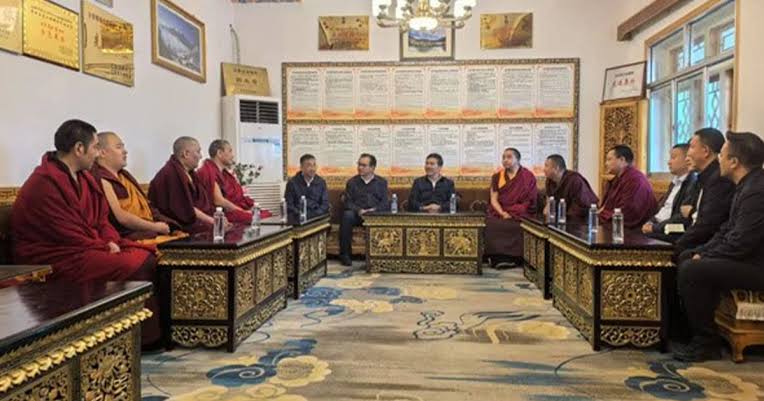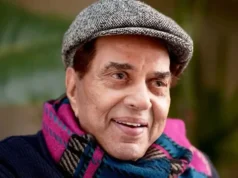In Tibet, heightened security and intimidation surround the Dalai Lama’s 90th birthday

As thousands of Tibetans and supporters around the world gathered to celebrate the 90th birthday of His Holiness the Dalai Lama on July 6, major commemorations took place in Dharamsala, India — the seat of the Tibetan exile community.
These included an official function organized by the Central Tibetan Administration, attended by foreign dignitaries and representatives, as well as a high-level meeting of the head lamas of Tibetan Buddhism, reaffirming support for the continuation of the Dalai Lama institution.
The events drew considerable attention from international media. In stark contrast, inside Tibet, the atmosphere remained tense and subdued. Heightened police and military presence has been reported in, but not limited to, the following Tibetan areas, cities and towns :-
• Lhasa city,
• Ngaba County
• Dzoge county
• Nyakchu County
• Lithang County
• Kumbum Monastery
• Labrang Monastery
• Ngago village
• Luchu County
• Xiahe County
• Pema County
• Kangtsa County
Numerous Chinese government officials have conducted visits to Tibetan areas and monasteries across Tibet in the lead-up to the July 6 birthday of the Dalai Lama, reflecting a broader strategy to enforce ‘stability.’
State media heavily promoted these government activities to ramp up warnings against expressions of support for the Dalai Lama.
The areas included cities and towns in the Tibet Autonomous Region, Qinghai Province, and Sichuan Province, while other parts of Tibet may also have been targeted.

Sun Xuetao, Minister of the United Front Work Department of the Kanlho Provincial Party Committee meeting with members of monastic management committees and teaching staff on his field research in towns and monasteries across Kanlho promoting Xi Jinping’s positions on Tibet-related work
Despite this climate, and consistent with the Tibetan spirit, many Tibetans released songs and sent well wishes to the Dalai Lama symbolizing acts of reverence to mark his birthday. Ahead of the birthday, the International Campaign for Tibet (ICT) issued the report “Celebrating in fear – China’s crackdown on Dalai Lama birthday tributes in Tibet”, detailing the persecution of Tibetans who celebrated the Nobel Peace Prize laureate’s birthday in the past.
Tencho Gyatso, president of the International Campaign for Tibet (ICT), said, “The heightened security around the Dalai Lama’s birthday shows that the Chinese government is conscious of the fact that its rule in Tibet does not enjoy support and legitimacy among Tibetans. We acknowledge the courage of many Tibetans in Tibet to express reverence to the Dalai Lama despite the pervasive climate of fear instilled by the authorities.”
Heightened military presence and surveillance
According to International Campaign for Tibet sources inside Tibet, between July 1-6, 2025, government officials held meetings in all monasteries across Lhasa to warn against “anti-separatist” activities, including targeting the major monastic learning centers of Drepung and Ganden. Military personnel also conducted 24-hour patrols in residential areas of Lhasa with significant Tibetan populations. Even food delivery drivers were allegedly forced to act as informants, monitoring people’s movements and activities.
In the lead up to the birthday, the Chinese government also carried out various propaganda activities in the Lhasa area. On June 30, Wang Junzheng, the Party Secretary of the Tibet Autonomous Region, met with the Chinese-selected Panchen Lama Gyaltsen Norbu.
During their meeting, Wang emphasized the importance of upholding the banner of “patriotism and love for party, ’unequivocally’ safeguarding national unity and ethnic solidarity, and opposing separatism”.
For a few days in July, the Chinese government specifically arranged for the Norbu to carry out “religious activities” in the Lhasa area. This aligns with the Chinese government’s usual practice of utilizing him during important dates in Tibet to obscure information about the Dalai Lama and external news from the devout public.
The official Chinese Tibet Daily newspaper reported that during his activities in Lhasa, Norbu emphasized the need to “deeply study and implement the Party’s Tibet governance policies to promote ethnic unity, religious harmony, and stability, development, and progress in Tibet.” He also stressed ensuring “harmony and stability in the religious sphere” was a crucial political task, which involves “providing education and guidance to monks and nuns on managing religious affairs in accordance with the law”.
Strict social media and public gathering bans
Sources inside Tibet have also reported that previously active and politically engaged areas of Ngaba and Dzoge are under intense “stability maintenance” measures. These measures include prohibiting the sharing of images of the Dalai Lama or other religious symbols on social media and bans on public gatherings for religious rituals or celebrations.
Officials across Kanlho also heightened restrictions. The official Kanlho Prefecture News Agency reported that since July 5, He Maobao, the Prefecture Party Secretary, has been conducting inspections at Labrang Monastery (བླ་བྲང་དགོན།), Terlung Monastery (གཏེར་ལུང་དགོན།), and Kirti Monastery (ཀིརྟི་དགོན) (Sangchu county branch).
Later, on July 8, Yang Wu, the Deputy Party Secretary of Kanlho Prefecture, reportedly conducted a follow-up inspection tour of Labrang Monastery and Amchok Monastery.
The top-down controls were also felt in Ngago (སྔ་སྒོ་ཡུལ་ཚོ།) village, Tsoe (གཙོས་གྲོང་ཁྱེར) city in Kanlho. According to a source, around the time of the Dalai Lama’s birthday, Chinese authorities searched more than 40 households and confiscated his photographs as well as those of high lamas living abroad. There are also reports that Tibetans were subjected to beatings and other forms of harassment.
Officials across Kardze TAP in Sichuan were also on alert. According to sources, in Lithang and Nyakchu counties, the Chinese government reportedly gathered all local leaders and issued directives to prevent any political issues around July 6.
Propaganda campaigns in monasteries
During the inspections at Labrang Monastery, police and relevant officials scrutinized monastery affairs. It was also stated that monks must obtain permission to leave the monastery and that religious activities must be strictly managed.
In both Labrang Monastery and across Luchu County, local officials held propaganda campaigns that promoted the “sinicization of Tibetan Buddhism,” banned “anti-separatism,” and demanded acceptance of China’s stance on the Dalai Lama’s reincarnation.
At Kumbum Monastery, in Amdo, Xining, first expanded by the third Dalai Lama and closely linked to the 14th Dalai Lama’s search and early life, sources in the region reported armed police conducted patrols and searched pilgrims and visitors on the Dalai Lama’s birthday.
These measures are consistent with the Chinese government’s long-standing policy of suppressing any expression of reverence for the Dalai Lama and asserting control over Tibetan religious practices, especially during significant dates like the Dalai Lama’s birthday.
Acts of Reverence
Despite the strict measures, some Tibetans inside Tibet marked the Dalai Lama’s birthday on social media platforms. Among them, a young Tibetan singer released a cover of an old song revering the Dalai Lama, which was widely shared on social media both inside and outside Tibet.
Translated extract of song lyrics:
“Born in Amdo (Eastern Tibet)
Having set foot in U-Tsang,
Whose activities are sustained from India,
Missing you, the Prince of Peace.”
Many Tibetans also shared symbolic images online with prayers for the Dalai Lama’s long life and good health. Some were more careful and creative when expressing their support.
One message featured images of Chenrezig, the Buddha of Compassion (the Dalai Lamas are believed to be his manifestation) accompanied by the last stanza of a prayer ‘Words of Truth,’ composed by the Dalai Lama in 1960.




